 |  |  |  |  |  |  |  |  |  |  |  |  |  |  |  |  |  |  |  |  |  |  |  |  |  |  |  |  |  |  |  |  |  |  |  |  |  |  |  |  |  |  |  |
 |
|
|
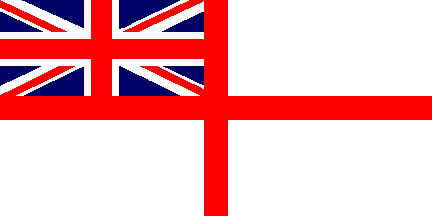 |
|
|
|
Leading Seaman Joseph Wood |
|
|
|
Nelson Battalion, Royal Naval Division |
|
|
|
|
 |
|
|
Joseph James Wood was born on 21 February 1883, at 229 New Road, Chatham. He was the third of Frederick Louis Wood's thirteen
children, and stayed behind in Britain when his parents emigrated to Canada in 1905.
|
|
|
|
New Road, Chatham |
|
|
|
 |
|
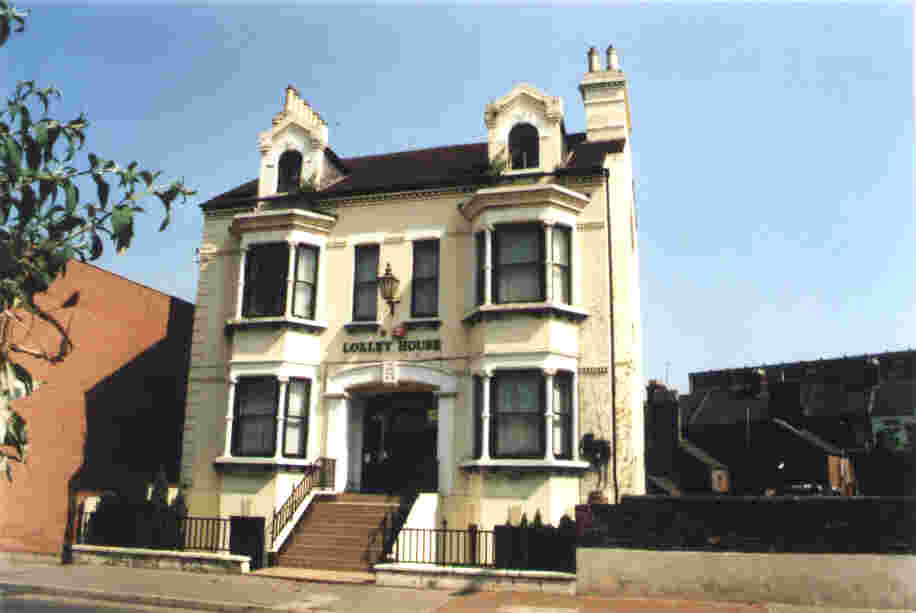 |
|
|
The house in which Joseph Wood was born, 229 New Road, no longer exists. It used to stand
to the right of the church in
the picture above left, ie where the apartment block now stands.
The only house surviving today from the row in which No.229 once stood, is No.209, pictured above right. |
|
|
|
 |
|
In August 1914, Joe Wood was thirty-one years old, and a member of the Royal Naval Volunteer Reserve. When it mobilised its
reserves at the outbreak of war, the Royal Navy had over 20,000 more reservists available than could be accomodated aboard its ships. By combining many of these with the men of the Royal Marines, it created a Royal Naval Division (RND), comprising three
brigades of four battalions (bns) each, which would fight as infantry on land. Joseph Wood was one of the reservists assigned to the 5th (Nelson) Bn of the RND's Second Brigade.
Joe first saw action early in the war, as the RND was sent to
Belgium on 6 October 1914, to help in the defence of the besieged city of Antwerp. Their goal was to ensure that Antwerp held out long enough |
|
|
|
|
to prevent the besieging German 4th Army from proceeding west to seize the Channel ports of Calais and Boulogne, and in this
they were successful. When Antwerp finally fell, the Division was withdrawn back to Britain (on 11 October), though in the confusion of the evacuation three of the four battalions of the First Brigade entered Dutch territory, and were interned for the
duration of the war.
Joe's Nelson Bn made it safely back to Britain, and was sent to temporary barracks in Portsmouth. Joe remained there until 27 November 1914, when the entire Second Brigade moved into the RND's newly-built training camp in
Blandford, Dorset. At Blandford, the RND was reorganised to make up for the loss of the three battalions left behind in the Netherlands, and Joe's battalion was switched to the First Brigade. At the same time, the Division gave up its characteristic
naval uniforms for conventional khaki, and began a period of intensive infantry training in preparation - though none if its members knew it yet - for a possible campaign in the spring of 1915 on Turkey's Gallipoli Peninsula.
(By the end of
1914, the British government was attracted to the idea of a campaign against Turkey, as the war against Germany on the Western Front seemed hopelessly deadlocked and immobile. They hoped to restart the war of movement by attacking and bringing to terms
Germany's less formidable ally, Turkey. The initial plan was for a group of older warships to force a passage through the heavily-mined and fortified Dardanelles Straits. With safe passage through the Dardanelles, the Royal Navy would have free access
to the Turkish capital, Constantinople, and Turkey could be forced out of the war. If the Dardanelles could not be forced by sea power alone, an infantry force might be dispatched in support).
Joe set sail for the Dardanelles from Bristol on 28th
February 1915, and reached Mudros Bay (on the Aegean Island of Lemnos) on 11 March. The following week, the RND was back at sea, participating in a diversionary naval attack aimed at drawing the attention of the Turks away from the attempt by seventeen
ships of the British and French navies to force a passage through the Dardanelles. Although it managed to silence the main Turkish land batteries defending the straits, the Allied force was crippled when seven of its ships struck mines, and the naval
attack had to be adandoned.
Recognising that the Dardanelles would not be taken by naval power alone, the British War Council decided that a Mediterranean Expeditionary Force would be assembled in Egypt, then despatched to make an amphibious
assault on the Gallipoli Peninsula, overlooking the northern shore of the Dardanelles. On 24 March, Joe Wood left Lemnos for Egypt, where he disembarked (at Port Said) four days later.
|
|
|
|
The Travels of Joseph Wood, 1914 - 1917 |
|
|
|
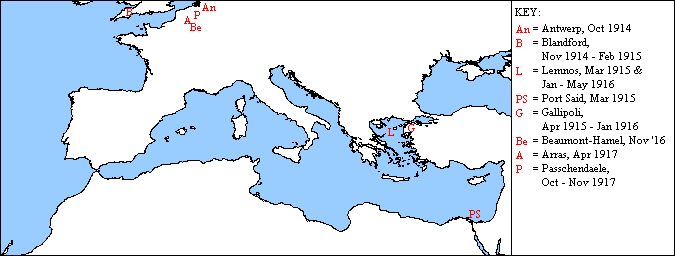 |
|
|
|
The Gallipoli landings were scheduled for 25 April 1915, with the British 29th Division landing on the southern part of the
Gallipoli Peninsula (around Cape Helles), and the Australia and New Zealand (ANZAC) Division going ashore further north at Gaba Tepe/Anzac Cove. Joe was not scheduled to take part in the amphibious assault, but would be at sea on 25 April, participating
in a diversionary action to draw Turkish defences away from the northern landing area.
Joe sailed from Port Said on 10 April, and was aboard ship in the Gulf of Saros when the ANZACs landed on 25 April. The 15,000 ANZACs at first met only
light resistance, but by the afternoon a counter-attack by the 19th Turkish Division had pushed them back into a cramped bridgehead on their landing beach. The RND's Nelson, Deal and Plymouth Bns came ashore at Anzac Cove three days, and from 28 April
to 12 May Joseph Wood fought in the defence of the Allied bridgehead there. Heavy Turkish counter-attacks continued at both Cape Helles and Anzac Cove for several weeks: all were repulsed with heavy casualties on both sides (including Joe's
eighteen-year-old brother, Harry, who was killed on the Helles Front on 4 June 1915, while serving with the RND's Anson Bn). The Gallipoli campaign then settled into a war of attrition, similar to that on the other fronts, with huge casualties on both
sides and little territorial gain by either.
|
|
|
|
The Royal Naval Division at ANZAC Cove, Gallipoli |
|
|
|
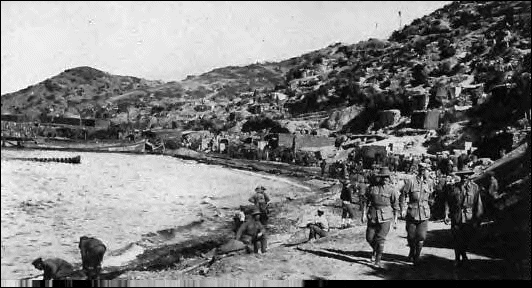 |
|
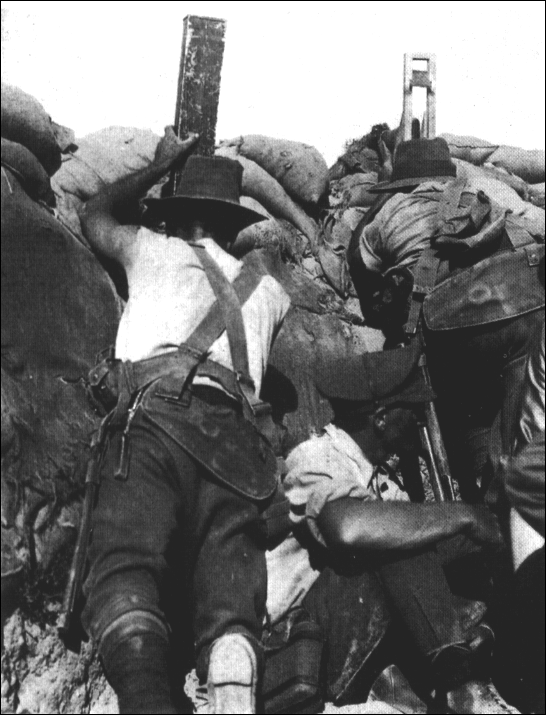 |
|
|
Photo: Photos of the Great War |
|
|
|
|
|
Above - The beachead at Anzac Cove, 1915.
Right - Australian troops and a soldier of the RND share a cramped forward trench
at Anzac Cove.
|
|
|
|
|
The heavy casualties of the Gallipoli landings forced a further reorganisation on the RND, which was reduced from three to two
brigades in July 1915. (Joe's Nelson Bn remained part of the First Bde). The surviving two RND brigades remained at Gallipoli until the general withdrawal of Allied forces from the Peninsula in December 1915 and January 1916. At this point, the
division was split up: the Second Brigade went from Gallipoli to Salonika, while Joe Wood's 1st Bde was assigned to police the Aegean islands of Tenedos, Imbros and Lemnos. Joe was stationed at Mudros, on Lemnos.
Nelson Bn remained on
garrison duties at Mudros until May 1916, when the RND's scattered battalions were reunited and sent to France for service on the Western Front. The arrival of substantial numbers of new recruits (to replace the men of the original RND who had been lost
at Gallipoli) meant that by mid-1916 most of the division was made up of soldiers who had no sea experience, and the division now passed from Royal Navy to Army control. Brought up to strength by the addition of Artillery and four Regular Army
battalions, the RND became the British Army's 63rd (Royal Naval) Division, comprising the 188th, 189th and 190th Brigades. |
|
|
On 22 May, Joe disembarked in Marseilles with the Nelson Bn, which was assigned to the 189th Bde. He spent his first weeks on
the Western Front in the Souchez Sector, a "quiet" sector north of Arras and facing Vimy Ridge. But in November 1916, the 63rd Division was sent south, to Beaumont-Hamel on the north bank of the River Ancre, to fight in the final engagement of the long
and bloody 1916 Allied Offensive, the Battle of the Somme. (Joe's younger brother, Fred, had been killed on the Somme five weeks before Joe arrived there).
At the Battle of the Ancre (13-15 November), Joe's 63rd Division held the right of the
British line, and was charged with advancing on three lines of enemy trenches on a spur overlooking Hamel. The advance was slow, through waterlogged trenches and shell-holes, and was immediately met by heavy machinegun fire. Most of Hawke and Nelson
Bn's officers quickly became casualties, but the men broke into small groups which continued to advance until, after a bitter bombing struggle, they occupied Station Trench and captured Beaumont-Hamel Station. The 63rd Division continued its slow
progress north, suffering fearful losses until, on 15 November it captured the village of Beaucourt-sur-Ancre, and was relieved by the 37th Division. |
|
|
Joseph Wood at the Battle of the Ancre,
13-15 November 1916. |
|
|
|
|
|
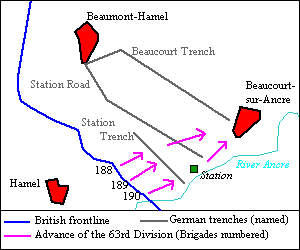 |
|
|
|
|
|
From the Somme, Joe Wood's Bn was sent back north in the spring of 1917, to the "quiet" sector it had occupied in the summer of
1916, during its first introduction to trench warfare. But the area around Arras was far from quiet during the spring of 1917, as that city was the site of a major British offensive, carried out in support of the French Nivelle Offensive in the
Champagne region. Both Joseph Wood and his younger brother Percy were in action at Arras: Percy's South Saskatchewan Bn took part in the Canadian Corps' successful assault on Vimy Ridge, while Joe's 189th Brigade advanced on and captured the town of
Gavrelle on the main Arras-Douai road in the Second Battle of the Scarpe (23 - 24 April). Four days later, the Marines of the 63rd Division suffered their heaviest losses of the war, in fighting around Gavrelle windmill. Fortunately for Joseph Wood the
Nelson Bn, having been in action on 23-24 April, was in reserve for the action on 28-29th, and so Joe survived the Battle of Arras. His brother Percy was less fortunate: he was killed on 5 May 1917, while his battalion was consolidating its hold on the
land won in the Vimy Offensive. |
|
|
|
After a period of leave in England - his first home leave for two years - Joe was sent north to Belgium in October 1917, to
fight in the final stages of the Third Battle of Ypres (Passchendaele). The Allies had launched their attack towards Passchendaele on 31 July, but their original goals of a swift breakthrough to the Flanders Plain and the Belgian Channel ports beyond
had quickly descended into a bitter war of attrition, and a slow, painful advance on the village of Passchendaele itself.
Upon arrival in Ypres Joseph Wood's 63rd Division was attached to XVII Corps of the British Fifth Army, which was preparing
for the final push of Third Ypres, to capture Passchendaele village. The attack began on 26 October, spearheaded by the Third and Fourth Canadian Divisions, with the 63rd supporting their left flank south of Poelcapelle. The 63rd's progress towards
Wallenmolen and Banff House over |
|
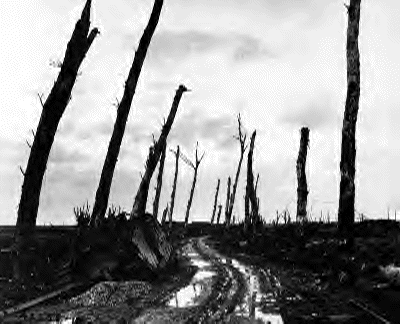 |
|
|
|
A street corner in Poelcapelle, 1918.
Photo : US National Archives and Records
Administration |
|
|
|
|
the next two weeks was slow and painstaking, through cloying mud. They advancing by taking one pillbox at a time, and
suffered heavy casualties from heavy barrages and fierce counter-attack. One of their many casualties was Joe Wood, who was killed in the vicinity of Sourd Farm in the final week of Third Ypres. Leading Seaman Joseph James Wood was killed in action on
3 November 1917, near Poelcapelle, Belgium, during the Second Battle of Passchendaele. He was one of the 40,000 British casualties whose bodies were never recovered from the waterlogged battlefield of Third Ypres, and he is commemorated on the Tyne Cot
Memorial to the Missing. |
|
|
|
Tyne Cot Cemetery and Memorial |
|
|
Details: The Commonwealth War Graves Commission |
|
|
|
Photo: David Cushing |
|
|
|
|
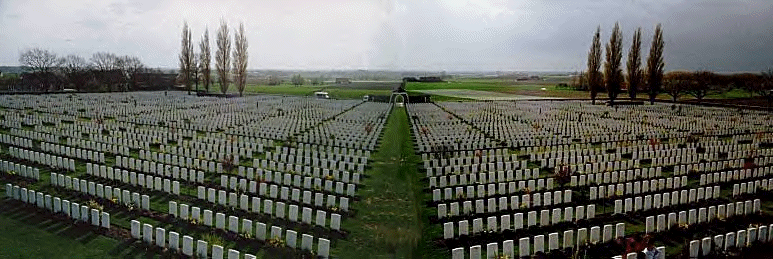 |
|
|
|
Tyne Cot Cemetery (above) stands on the high ground on the western slopes of Passchendaele Ridge, where some of the most
desperate fighting of Third Ypres occurred. It is the largest Commonwealth War Graves Cemetery in the World, containing the graves of 12,000 men killed in the Passchendaele and Langemarck areas between August 1917 and the end of the war. Nearly 8,400
of the graves are unnamed, and the names of the unidentified soldiers who lie in them are among those inscribed on the panels of the Tyne Cot Memorial (right), which takes the form of a semi-circular wall around the rear of the cemetery.
The
Memorial is inscribed with the names of almost 35,000 British soldiers who died in the Ypres Salient between August 1917 and November 1918. Joseph Wood is commemorated on Panel 162.
|
|
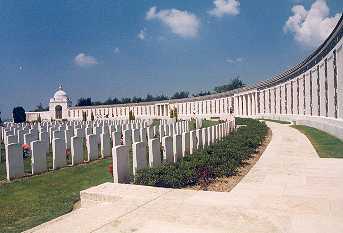 |
|
|
Photo courtesy: M. Stamp |
|
|
|
 |
|
|
|
 |
|
 |
|
 |
|
|
|
or return to Biographies home page |
|











